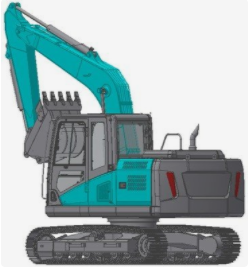A crawler hydraulic excavator is an earth-moving machine that uses a bucket to excavate materials above or below the bearing surface and load it into a transport vehicle or unload it to a stockyard. The excavated materials are mainly soil, coal, silt, soil and rock after pr-loosening.
Judging from the development of construction machinery in recent years, the development of excavators is relatively fast. As one of the most important construction machinery models in engineering construction, the correct selection of excavators is more important. Special machinery and equipment widely used in mining and urban and rural construction with advanced performance and unique technology.
Chinese name: Crawler hydraulic excavator
Foreign name: excavating machinery
Uses: mining and urban and rural construction
Introduction: Digging and filling material with a bucket
It has been more than 130 years since the first manual excavator came out. During this period, it has experienced the gradual development from steam-driven bucket rotary excavators to electric-driven and internal-combustion-engine-driven rotary excavators, and fully automatic hydraulic excavators using electroencephalographic integration technology. process.
Due to the application of hydraulic technology, there was a mounted excavator equipped with a hydraulic backhoe on a tractor in the 1940s. In the early and mid-1950s, a trailed azimuth hydraulic excavator and a crawler full hydraulic excavator were successively developed. .
The initial trial-produced hydraulic excavator adopts the hydraulic technology of aircraft and machine tools, lacks hydraulic components suitable for various working conditions of the excavator, the manufacturing quality is not stable enough, and the supporting parts are not complete.
Since the 1960s, hydraulic excavators have entered a stage of promotion and vigorous development. The number of excavator manufacturers and varieties in various countries has increased rapidly, and the output has soared.
From 1968 to 1970, the output of hydraulic excavators accounted for 83% of the total output of excavators, and it is now close to 100%.
The excavator was originally manual, and it has been more than 130 years since its invention, and it has experienced various driving methods such as steam drive, electric drive, and internal combustion engine drive.
After the 1940s, hydraulic technology was applied to excavators, and in the 1950s, the crawler-type full-hydraulic excavators that are common today were developed.
The three most important parameters of excavators: vehicle weight (mass), engine power and bucket capacity.
In 1951, the first fully hydraulic backhoe was launched at the McClain factory in France, thus creating a new space in the field of technical development of excavators.
constitute
Common excavator structures include power units, working devices, slewing mechanisms, manipulation mechanisms, transmission mechanisms, walking mechanisms and auxiliary facilities.
From the appearance, the excavator is composed of three parts: the working device, the upper turntable and the traveling mechanism.
Classification
The following is a classification of common excavators:
Category 1: Common excavators are divided into two types: internal combustion engine-driven excavators and electric-driven excavators. Among them, electric excavators are mainly used in plateau hypoxia, underground mines and other flammable and explosive places.
Classification 2: According to the different walking methods, excavators can be divided into crawler excavators and wheeled excavators.
Classification 3: According to the different transmission methods, excavators can be divided into hydraulic excavators and mechanical excavators. Mechanical excavators are mainly used in some large mines.
Classification 4: According to the use, excavators can be divided into general excavators, mining excavators, marine excavators, special excavators and other different categories
The vast majority of today’s excavators are fully hydraulic azimuth excavators. Caterpillar 385B Excavator
Hydraulic excavators are mainly composed of engine, hydraulic system, working device, traveling device and electrical control. The hydraulic system consists of hydraulic pump, control valve, hydraulic cylinder, hydraulic motor, pipeline, fuel tank, etc. The electrical control system includes monitoring panel, engine control system, pump control system, various sensors, solenoid valves, etc.
According to its structure and use, it can be divided into:
Crawler type, tire type, walking type, full hydraulic, semi-hydraulic, azimuth, non-azimuth, general, special, articulated, telescopic boom and other types.
The working device is the device that directly completes the excavation task. It is hinged from three parts: boom, stick and bucket. Boom lift, stick extension and bucket rotation are controlled by reciprocating double-acting hydraulic cylinders.
In order to meet the needs of various construction operations, hydraulic excavators can be equipped with a variety of working devices, such as digging, lifting, loading, leveling, clamps, bulldozing, impact hammers and other working tools.
The slewing and traveling device is the body of the hydraulic excavator, and the upper part of the turntable is provided with a power device and a transmission system. The engine is the power source of the hydraulic excavator, most of which use diesel oil in a convenient place, and can also use an electric motor instead.
The hydraulic transmission system transmits the power of the engine to the hydraulic motor, hydraulic cylinder and other actuators through the hydraulic pump, and pushes the working device to move, thereby completing various operations.
Post time: Jun-29-2022





